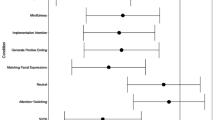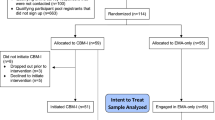Abstract
Cognitive Bias Modification to reduce threat interpretations (CBM-I) is a computer-based paradigm designed to train a less negative interpretation bias that has shown some success in the lab, but results for web-based CBM-I are often mixed. To test possible explanations for the poorer results online, participants high in social anxiety (N = 379) were recruited from Amazon’s Mechanical Turk to complete a single-session, proof-of-principle study to investigate: (1) whether web-based CBM-I can shift interpretations of social situations to be less negative and reduce anticipatory social anxiety, (2) whether a common “control” condition used in CBM-I studies is in fact inert by incorporating an alternate control condition, and (2) whether priming anxious imagery prior to training moderates CBM-I’s effects. Participants were randomly assigned to one of three training conditions: all positive, half positive/half negative, or neutral unemotional scenarios. Participants also received an anxious or neutral imagery prime before training. Although results were somewhat mixed across outcome measures, findings generally suggested that participants exhibited less negative interpretations of ambiguous social scenarios following positive training with an anxious imagery prime. There was also some evidence that the neutral training condition was associated with less negative interpretations, and evidence that the half positive/half negative training condition led to the least anticipatory anxiety, especially when paired with anxious imagery. Findings are discussed in light of different training effects for near- and far-transfer outcomes.


Similar content being viewed by others
Notes
One participant listed his/her age as fourteen, but we are attributing this to participant error because the study site on Mturk allowed only U.S. citizens and adults (18 and older) to view the study to participate.
Significant results remained when SIAS score was not included as a covariate.
Note, we also analyzed the data using baseline SIAS as a moderator given some prior evidence that severity of social anxiety symptoms can moderate training effects in an unselected sample (Steinman and Teachman 2015); however, we do not include these analyses here because of the limited range of social anxiety symptoms in this sample that was selected to all be relatively high in social anxiety. Full results available from second author.
References
Amin, N., Foa, E. B., & Coles, M. E. (1998). Negative interpretation bias in social phobia. Behaviour Research and Therapy, 36(10), 945–957. https://doi.org/10.1016/S0005-7967(98)00060-6.
Beadel, J. R., Mathews, A., & Teachman, B. A. (2016). Cognitive bias modification to enhance resilience to a panic challenge. Cognitive Therapy and Research. https://doi.org/10.1007/s10608-016-9791-z.
Beard, C. (2011). Cognitive bias modification for anxiety: Current evidence and future directions. Expert Review of Neurotherapeutics, 11(2), 299–311. https://doi.org/10.1586/ern.10.194.
Beard, C., Sawyer, A. T., & Hofmann, S. G. (2012). Efficacy of attention bias modification using threat and appetitive stimuli: A meta-analytic review. Behavior Therapy, 43(4), 724–740. https://doi.org/10.1016/j.beth.2012.01.002.
Beck, A. T., & Clark, D. A. (1997). An information processing model of anxiety: Automatic and strategic processes. Behaviour Research and Therapy, 35(1), 49–58. https://doi.org/10.1016/S0005-7967(96)00069-1.
Boettcher, J., Berger, T., & Renneberg, B. (2012). Internet-based attention training for social anxiety: A randomized controlled trial. Cognitive Therapy and Research, 36(5), 522–536. https://doi.org/10.1007/s10608-011-9374-y.
Brosan, L., Hoppitt, L., Shelfer, L., Sillence, A., & Mackintosh, B. (2011). Cognitive bias modification for attention and interpretation reduces trait and state anxiety in anxious patients referred to an out-patient service: Results from a pilot study. Journal of Behavior Therapy and Experimental Psychiatry, 42(3), 258–264. https://doi.org/10.1016/j.jbtep.2010.12.006.
Carlbring, P., Apelstrand, M., Sehlin, H., Amir, N., Rousseau, A., Hofmann, S. G., & Andersson, G. (2012). Internet-delivered attention bias modification training in individuals with social anxiety disorder—a double blind randomized controlled trial. BMC Psychiatry. https://doi.org/10.1186/1471-244X-12-66.
Clark, D. M., Salkovskis, P. M., Öst, L.-G., Breitholtz, E., & Koehler, K. A., Westling, B. E., Jeavons, A., & Gelder, M. (1997). Misinterpretation of body sensations in panic disorder. Journal of Consulting and Clinical Psychology, 65(2), 203–213. https://doi.org/10.1037/0022-006X.65.2.203
Cristea, I. A., Kok, R. N., & Cuijpers, P. (2015). Efficacy of cognitive bias modification interventions in anxiety and depression: Meta-analysis. British Journal of Psychiatry, 206(1), 7–16. https://doi.org/10.1192/bjp.bp.114.146761.
de Boer, M. R., Waterlander, W. E., Kuijper, L. D., Steenhuis, I. H., & Twisk, J. W. (2015). Testing for baseline differences in randomized controlled trials: An unhealthy research behavior that is hard to eradicate. International Journal of Behavioral Nutrition and Physical Activity, 12(4), 1–8. https://doi.org/10.1186/s12966-015-0162-z.
First, M. B., Spitzer, R. L., Gibbon, M., & Williams, J. B. W. (1995). Structured clinical interview for DSM-IV axis I disorders. New York: New York State Psychiatric Institute.
Foa, E. B., & Kozak, M. J. (1986). Emotional processing of fear: Exposure to corrective information. Psychological Bulletin, 99(1), 20–35.
Green, J. S., & Teachman, B. A. (2012). Is “cootie” in the eye of the beholder? An experimental attempt to modify implicit associations tied to contamination fears. Journal of Experimental Psychopathology, 3(3), 479. https://doi.org/10.5127/jep.026111.
Hallion, L. S., & Ruscio, A. M. (2011). A meta-analysis of the effect of cognitive bias modification on anxiety and depression. Psychological Bulletin, 137(6), 940–958. https://doi.org/10.1037/a0024355.
Heimberg, R. G., Brozovich, F. A., & Rapee, R. M. (2010). A cognitive-behavioral model of social anxiety disorder: Update and extension. In S. G. Hofmann & P. M. DiBartolo (Eds.), Social anxiety: Clinical, developmental, and social perspectives, Amsterdam: Elsevier, pp. 395–422.
Heimberg, R. G., Mueller, G. P., Holt, C. S., Hope, D. A., & Liebowitz, M. R. (1992). Assessment of anxiety in social interaction and being observed by others: The social interaction anxiety scale and the social phobia scale. Behavior Therapy, 23(1), 53–73. https://doi.org/10.1016/S0005-7894(05)80308-9.
Hirsch, C. R., & Clark, D. M. (2004). Information-processing bias in social phobia. Clinical Psychology Review, 24(7), 799–825. https://doi.org/10.1016/j.cpr.2004.07.005.
Hirsch, C. R., & Holmes, E. A. (2007). Mental imagery in anxiety disorders. Psychiatry, 6(4), 161–165. https://doi.org/10.1016/j.mppsy.2007.01.005.
Hirsch, C. R., & Mathews, A. (2000). Impaired positive inferential bias in social phobia. Journal of Abnormal Psychology, 109(4), 705–712. https://doi.org/10.1037/0021-843x.109.4.705.
Katzelnick, D. J., & Greist, J. H. (2001). Social anxiety disorder: An unrecognized problem in primary care. Journal of Clinical Psychiatry, 62(Suppl1), 11–16.
Kessler, R. C., Petukhova, M., Sampson, N. A., Zaslavsky, A. M., & Wittchen, H. R. (2012). Twelve-month and lifetime prevalence and lifetime morbid risk of anxiety and mood disorders in the United States. International Journal of Methods in Psychiatric Research, 21(3), 169–184. https://doi.org/10.1002/mpr.1359.
Kuckertz, J. M., & Amir, N. (2015). Attention bias modification for anxiety and phobias: Current status and future directions. Current Psychiatry Reports, 17(2), 1–8. https://doi.org/10.1007/s11920-014-0545-x.
Kuckertz, J. M., Gildebrant, E., Liliequist, B., Karlström, P., Väppling, C., Bodlund, O., Stenlund, T., Hofmann, S. G., Andersson, G., Amir, N., & Carlbrin, P. (2014). Moderation and mediation of the effect of attention training in social anxiety disorder. Behaviour Research and Therapy, 53, 30–40. https://doi.org/10.1016/j.brat.2013.12.003.
Leary, M. R. (1983). A brief version of the fear of negative evaluation scale. Personality and Social Psychology Bulletin, 9, 371–376. https://doi.org/10.1177/0146167283093007.
MacLeod, C., & Mathews, A. (2012). Cognitive bias modification approaches to anxiety. Annual Review of Clinical Psychology, 8(1), 189–217. https://doi.org/10.1146/annurev-clinpsy-032511-143052.
Mathews, A., & Mackintosh, B. (2000). Induced emotional interpretation bias and anxiety. Journal of Abnormal Psychology, 109(4), 602–615. https://doi.org/10.1037//002I-843X.109.4.602.
Mattick, R. P., & Clarke, J. C. (1998). Development and validation of measures of social phobia scrutiny fear and social interaction anxiety. Behaviour Research and Therapy, 36(4), 455–470. https://doi.org/10.1016/S0005-7967(97)10031-6.
Menne-Lothmann, C., Viechtbauer, W., Höhn, P., Kasanova, Z., Haller, S. P., Drukker, M., van Os, J., Wichers, M., & Lau, J. Y. F. (2014). How to boost positive interpretations? A meta-analysis of the effectiveness of cognitive bias modification for interpretation. PLoS ONE, 9(6), e100925. https://doi.org/10.1371/journal.pone.0100925.
Murphy, R., Hirsch, C. R., Mathews, A., Smith, K., & Clark, D. M. (2007). Facilitating a benign interpretation bias in a high socially anxious population. Behaviour Research and Therapy, 45(7), 1517–1529. https://doi.org/10.1016/j.brat.2007.01.007.
Pearson, D. G., Deeprose, C., Wallace-Hadrill, S. M., Heyes, S. B., & Holmes, E. A. (2013). Assessing mental imagery in clinical psychology: A review of imagery measures and a guiding framework. Clinical Psychology Review, 33(1), 1–23. https://doi.org/10.1016/j.cpr.2012.09.001.
Rapee, R., & Heimberg, R. (1997). A cognitive-behavioral social model phobia of anxiety. Behaviour Research and Therapy, 35(8), 741–756. https://doi.org/10.1016/S0005-7967(97)00022-3.
Reuland, M. M., Steinman, S. A., & Teachman, B. A. (2015). Cognitive bias modification in mental. emerging trends in the social and behavioral sciences: An interdisciplinary. Searchable, and Linkable Resource. https://doi.org/10.1002/9781118900772.etrds0045.
Salemink, E., Kindt, M., Rienties, H., & van den Hout, M. (2014). Internet-based cognitive bias modification of interpretations in patients with anxiety disorders: A randomised controlled trial. Journal of Behavior Therapy and Experimental Psychiatry, 45(1), 186–195. https://doi.org/10.1016/j.jbtep.2013.10.005.
Salemink, E., van den Hout, M., & Kindt, M. (2009). Effects of positive interpretive bias modification in highly anxious individuals. Journal of Anxiety Disorders, 23(5), 676–683. https://doi.org/10.1016/j.janxdis.2009.02.006.
Steinman, S. A., & Teachman, B. A. (2014). Reaching new heights: Comparing interpretation bias modification to exposure therapy for extreme height fear. Journal of Consulting and Clinical Psychology, 82(3), 404. https://doi.org/10.1007/s10608-006-9084-z.
Steinman, S. A., & Teachman, B. A. (2015). Training less threatening interpretations over the internet: Does the number of missing letters matter? Journal of Behavior Therapy and Experimental Psychiatry, 49, 53–60. https://doi.org/10.1016/j.jbtep.2014.12.004.
Stopa, L., & Clark, D. (2000). Social phobia and interpretation of social events. Behaviour Research and Therapy, 38(3), 273–283. https://doi.org/10.1016/S0005-7967(99)00043-1.
Teachman, B. A., & Addison, L. M. (2008). Training non-threatening interpretations in spider fear. Cognitive Therapy Research, 32(3), 448–459. https://doi.org/10.1007/s10608-006-9084-z.
Acknowledgements
We are thankful to Emily Holmes, Simon Blackwell, Andrew Mathews, Bundy Mackintosh and their research teams for sharing some of their training materials. Some of their scenarios were included, typically in a modified form, as part of our training materials. We would also like to thank Shari Steinman and Alexandra Werntz for creating scenarios for the training task. Also, thanks to members of the Teachman Program for Anxiety, Cognition, and Treatment (PACT) Lab for their feedback and suggestions on this study. This research was supported in part by an NIMH grant (NIMH R34MH106770), as well as a Templeton Science of Prospection Award, to B. Teachman. Note, Teachman has a significant financial interest in Project Implicit, Inc., which provided services in support of this project under contract with the University of Virginia.
Funding
This study was funded by National Institute of Mental Health grants R34MH106770 and R01MH113752.
Author information
Authors and Affiliations
Corresponding author
Ethics declarations
Conflict of Interest
B. Teachman has a significant financial interest in Project Implicit, Inc., which provided services for hosting data collection for this project. C. Edwards, S. Portnow and N. Namaky declares that they have no conflict of interest.
Ethical Approval
All procedures performed in studies involving human participants were in accordance with the ethical standards of the institutional and/or national research committee and with the 1964 Helsinki declaration and its later amendments or comparable ethical standards.
Informed Consent
Informed consent was obtained from all individual participants included in the study.
Animal Rights Statements
No animal studies were carried out by the authors for this article.
Electronic supplementary material
Below is the link to the electronic supplementary material.
Rights and permissions
About this article
Cite this article
Edwards, C.B., Portnow, S., Namaky, N. et al. Training Less Threatening Interpretations Over the Internet: Impact of Priming Anxious Imagery and Using a Neutral Control Condition. Cogn Ther Res 42, 832–843 (2018). https://doi.org/10.1007/s10608-018-9922-9
Published:
Issue Date:
DOI: https://doi.org/10.1007/s10608-018-9922-9




